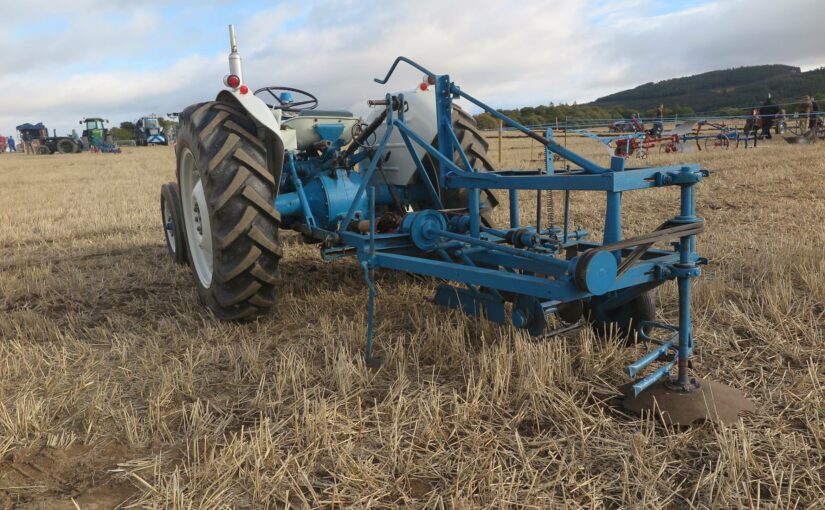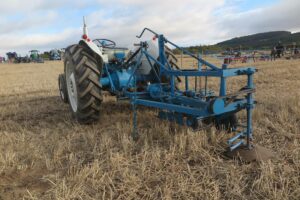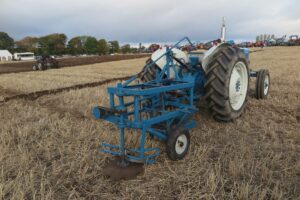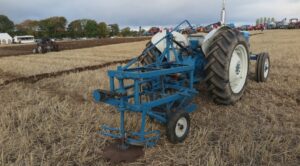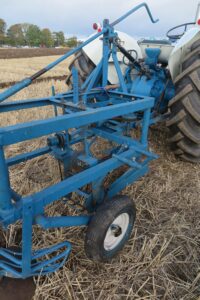The various attempts to mechanise the harvesting of the turnip crop continued into the twentieth century. Not only did there continue to be national trials but also locally arranged ones. Important ones were held in 1919 and 1920. The national agricultural society, the Royal Highland and Agricultural Society of Scotland, held one in 1919. It had varying degrees of success. One of the machines at it, made by Smith and Wood, Forfarshire, was later exhibited in local competitions.
Accounts of these demonstrations were held in the national and local newspapers. As with other trials, they provide a good deal of information, including context to the event, the judges, attendees, and lengthy descriptions on the machines and how they worked.
The following are accounts of these trials. The first was published in The Scotsman on 21 November 1919 and the second in the Dundee Courier of 4 March 1920:
“Turnip lifting machines
Highland Society’s trial
The mechanical age of farming has come to realisation during the stress of war days. Time has marched with great strides in the matter of mechanical labour-saving services. If through the exigencies of war it has been in these later years in the nature of a forced march, it has only resulted in the farmer’s adoption of the mechanical idea being more rapid. Within the last four years every farmer throughout the country has been brought prominently before him a demonstration of all sorts and makes of tractor implements. The shortage of labour and its high cost are even more pronounced since the war ended, and the farmer is eager to consider the application of time and labour saving machines to other departments of agriculture than that of cultivation. In no other branch of field work is there greater need for mechanisation aid than in that of turnip lifting, topping, and tailing. It is a slow and laborious job when done by hand labour, and a costly business for the farmer when wages have soared as high as they are at the present time.
The Highland and Agricultural Society, which has been ever ready and willing to promote the interests of the farmers of Scotland, organised a two days’ trial of turnip lifting machines, at the farm of Turnhouse, near Edinburgh, tenanted by Messrs J. & W. Young. The trial was postponed owing to the bad weather, took place yesterday, and attracted a large gathering of practical agriculturists from all parts of the country. The Board of Agriculture for Scotland was represented by Messrs James Wood, F. Thomson, and A. D. Callander, and among others present were Sir Robert Moncrieffs. Mr C. M. Douglas CB, of Auchlochan, ex-chairman of directors of the Society; Mr Phipps O. Turnbull, Smeaton, Dalkeith, convener of the Implement Committee; Mr G. G. Mercer, Southfield, Dalkeith, vice-president of the Scottish Chamber of Agriculture; and Mr John Stirton, secretary of the Secretary.
The judges were Mr J. T. McLaren, The Leuchold, Dalmeny; Mr A. B. Leitch, Inchstelly, Alves, Forres; and Professor Stanfield, the Society’s consulting engineer.
Four machines were entered by Messrs Teasdale Bros (Ltd), Darlington; Smith & wood, Montrose; D. Wilson, East Linton; and George Henderson, Kelso. The last named did not put in an appearance, and Mr Wilson’s machine, though at the station, was not got out in time for the demonstration. It will be shown to-day.
The Teasdale machine was the first at work. It has been in use for some time by progressive farmers in Scotland, who report that it has given every satisfaction. A Ross-shire farmer declares that in 1916 it made good progress. With the lifting of the swedes, and did splendid work, “far above my expectation of any machine”. In the machine there are two dividers, which carry the tops into an upright position until they are gripped by two travelling belts. Whilst in this position the tops are cut off by an adjustable knife which automatically adapts itself to suit the different size of roots. The hand lever at the back is connected to a knife which cuts off the roots of the plants. The test which was given to the machine yesterday was a very severe one. The soil was wet and sticky, and the shaws were short and lying to the side. The machine did better work with the yellows than with the swedes, though many farmers were disappointed at the way in which the turnips were scattered about.
Messrs Smith & Wood’s turnip harvester, which is designed to top, tail, clean, and row turnips, did not show to advantage. At a preliminary trial held in Forfarshire it was reported that the machine had done excellent work, but as in the case of the Teasdale machine, the conditions were not favourable for it. The machine, which was exhibited at the Highland Society’s show in Edinburgh, attracted considerable attention because of its novel features. The shaws are removed by a circular saw, which is carried on a self-adjusting frame. The tails of the turnips are removed by a knife, travelling below the ground, which is also adjustable. Attached to this knife is a guide, which passes the turnips (now topped and tailed) sideways into the elevator wheel. As the wheel revolved the turnips are carried to the top and discharged into a shoot. Unfortunately the machine was not seen in good working order yesterday, and its merits could not be fully demonstrated.”
“Turnip harvester demonstration
Machine invented by Forfarshire men
Performs a triple role
The keen interest which is being taken by agriculturists in the turnip harvester, a Forfarshire invention, invented, patented, and made by Messrs Smith & Wood (Mr Alex Smith, Lethnot, and Major W. M. Wood, Montrose), was evidenced by the large and representative gathering of prominent Forfarshire farmers present at Balmakewan, Marykirk, yesterday afternoon, when a successful demonstration of the capabilities of the machine was given.
The machine, which is of compact and not too heavy appearance, is unique in respect that it tops, tails, and rows turnips simultaneously.
Yesterday afternoon the field on which the trial was made, kindly granted by Mr Wm Low, Balmakewan, was in ideal condition for the purpose, and the demonstration was an all-round success. In less than half-an-hour the harvester completed a piece of work in a thoroughly complete fashion which would have taken a man no less than five and a half hours to accomplish.
The general comments of those present were in entire praise of the machine, and one prominent agriculturist very aptly remarked, “the only manual work to be seen shortly will be the putting of the turnips into the cart”.
The machine is provided with a large wheel, which travels between the drills. In the inner periphery of the wheel there are a number of buckets or receptacles-spaced at regular intervals-for receiving the turnips after they have been topped and tailed.
The wheel and buckets are of open construction so as to facilitate the removal of the soil adhering to the turnips. The topping is effected by a revolving cutter provided with large teeth somewhat similar to a circular saw.
The cutter is mounted on a vertical spindle driven by chain and sprocket gearing off the main wheel axle, and carried on to a framework which is self-adjusting to suit the height of the turnips in the drills.
The tails are removed by means of a horizontal knife travelling below the ground and placed behind the cutter and attached to a frame consisting of a number of bars. This frame is set at an angel of about 30 degrees with the length of the drill and with the face of the wheel.
The action of this frame is to balance the turnips, after being topped and tailed, out of the drill and into the periphery of the wheel. The turnips are conveyed by the buckets to the highest point of the wheel, and there fall to an inclined shoot, which delivers them into an adjacent furrow. The shoot is provided with a. folding section about halfway down its length, and is so arranged that the turnips from four adjacent drills-two up and two down-are deposited in the same furrow.
The last demonstration of the turnip harvester was held in November last year under the auspices of the Highland and Agricultural Society, and it is interesting to note the judges’ report on that occasion was as follows: -“The character of the crop and the condition of the land probably had an adverse influence on the working of the machine, which appears to have several novel and interesting features, and if certain mechanical defects can be remedied there seems to be no reason why it should not do efficient work.”
